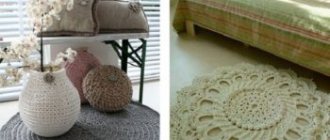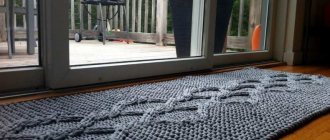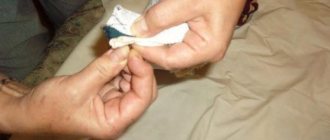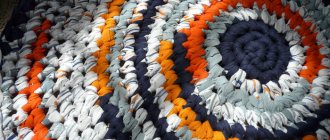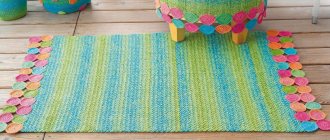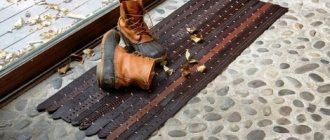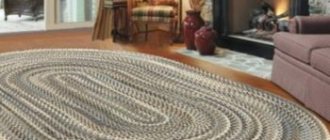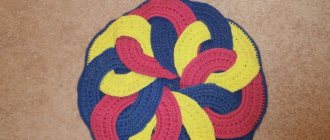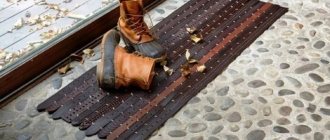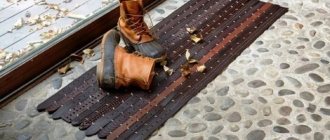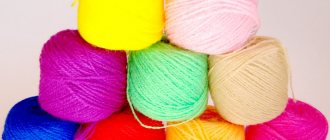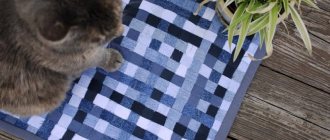Polyester cord for knitting carpets
Relatively recently, carpets and rugs began to be knitted from polyester cord. This is the same material from which the “Grand” and “Magnificent” carpets are knitted; many of you have probably heard such names. But of course any other products.
The pattern of the “Magnificent” carpet is here>>.
Despite the fact that this material is synthetic, it looks like natural, is soft to the touch, stretches well, is springy, does not fade, does not collect dust and does not become electrified.
It makes simply gorgeous carpets; rugs in the form of napkins, knitted according to the same patterns as openwork thin napkins, are especially popular. They can be laid in the most stylish interior in the living room. A carpet made from cord is voluminous and looks rich and elegant.
For knitting carpets, it is recommended to choose a polyester cord with a core, also called “cord in a cord”, with a diameter of 4.5-5 mm.
You can buy it in online stores; the range is now quite large and the color range is varied.
Consumption: for a rug with a diameter of one meter - approximately 600 meters of cord, for a rug with a diameter of two meters - 2000 m.
Recommended hook number is 7.
Disadvantages : Perhaps the only disadvantage of this material is its high cost: 2.5-2.8 rubles per meter.
What else will you need for work?
To work with thick yarn, you need a hook number 5-8. You can try different sizes, knit samples and evaluate the result. The carpet in the bathroom should be dense, without unnecessary openwork.
Before starting work, you need to wash your hands, especially if the threads are light. The finished product should be washed, but it is better to keep it clean during the process.
Crochet hooks should be large and have a strong handle.
Knitted (tape) yarn for crocheted rugs
No less popular is knitted yarn for crochet rugs. Or another name - ribbon, which probably characterizes its essence: fabric cut into ribbons 2-3 cm wide, which are rolled into a tube. This is the kind of yarn our great-grandmothers have long used to knit circles for the floor.
Even now, needlewomen often make it with their own hands from old knitted T-shirts.
How to make yarn from T-shirts and examples of products from it
But factory production of knitted yarn is now well established and you can purchase it both online and in handicraft stores.
The yarn is made from cotton jersey, sometimes with the addition of polyester.
The most used brands are “Lenta”, “Spaghetti” and others.
They also make wonderful fashionable baskets from it. We have both diagrams and master classes for those.
Most often, the yarn is wound into balls weighing approximately 350 grams, the length of the thread is 100 m, and its width (diameter of the “tube”) is 7-9 mm.
Very beautiful rugs are made from knitted yarn; they are of such high quality, smooth, shiny, dense, hold their shape well, and the pattern in them is clearly visible.
They knit very easily and quickly, as the thread is thick, and they look amazing!
Consumption: approximately 5 balls per mat 1 m in diameter.
Hook number: 12.
Disadvantages : yarn is not cheap, the cost of one ball is around 350 rubles. But homemade yarn still needs to be prepared, and finding a certain number of T-shirts of the same color is probably not so easy, although you can knit a multi-colored rug.
LiveInternetLiveInternet
Advice from Olga Smirnova from the blog “The Comfort and Warmth of My Home”
Yarn for crocheting rugs
- polyester cord
- knitted
- plastic bags
- acrylic, wool
- leg-split
Each of them is good and suitable for knitting rugs, but has its own characteristics, advantages and disadvantages.
Polyester cord
Relatively recently, carpets and rugs began to be knitted from polyester cord. This is the same material from which the “Grand” and “Magnificent” carpets are knitted; many of you have probably heard such names. But of course any other products.
The pattern of the “Magnificent” carpet is here>>.
Despite the fact that this material is synthetic, it looks like natural, is soft to the touch, stretches well, is springy, does not fade, does not collect dust and does not become electrified.
It makes simply gorgeous carpets; rugs in the form of napkins, knitted according to the same patterns as openwork thin napkins, are especially popular. They can be laid in the most stylish interior in the living room. A carpet made from cord is voluminous and looks rich and elegant.
For knitting carpets, it is recommended to choose a polyester cord with a core, also called “cord in a cord”, with a diameter of 4.5-5 mm.
You can buy it in online stores; the range is now quite large and the color range is varied.
Consumption: for a rug with a diameter of one meter - approximately 600 meters of cord, for a rug with a diameter of two meters - 2000 m.
Recommended hook number is 7.
Disadvantages : Perhaps the only disadvantage of this material is its high cost: 2.5-2.8 rubles per meter.
Knitted (tape) yarn
No less popular is knitted yarn for crochet rugs. Or another name - ribbon, which probably characterizes its essence: fabric cut into ribbons 2-3 cm wide, which are rolled into a tube. This is the kind of yarn our great-grandmothers have long used to knit circles for the floor.
Even now, needlewomen often make it with their own hands from old knitted T-shirts.
How to make yarn from T-shirts and examples of products from it
But factory production of knitted yarn is now well established and you can purchase it both online and in handicraft stores.
The yarn is made from cotton jersey, sometimes with the addition of polyester.
The most used brands are “Lenta”, “Spaghetti” and others.
Most often, the yarn is wound into balls weighing approximately 350 grams, the length of the thread is 100 m, and its width (diameter of the “tube”) is 7-9 mm.
Very beautiful rugs are made from knitted yarn; they are of such high quality, smooth, shiny, dense, hold their shape well, and the pattern in them is clearly visible.
They knit very easily and quickly, as the thread is thick, and they look amazing!
Consumption: approximately 5 balls per mat 1 m in diameter.
Hook number: 12.
Disadvantages : yarn is not cheap, the cost of one ball is around 350 rubles. But homemade yarn still needs to be prepared, and finding a certain number of T-shirts of the same color is probably not so easy, although you can knit a multi-colored rug.
Yarn from plastic bags
Surprisingly, rugs can even be knitted from plastic bags! Our inventors learned how to make ribbon-type yarn from them.
At one time, such knitting became incredibly popular.
Garbage bags are better suited for rugs; they come in different colors, so you can choose the one that suits you. Needlewomen advise taking bags that are not very thick to make knitting more convenient.
Polyethylene rugs are moisture-resistant and durable. This is an ideal option for the bathroom, they don’t slip even on a wet floor, and when leaving the bathroom, you don’t have to be afraid of slipping on them, water doesn’t accumulate under them, and they dry quickly enough.
Consumption of packages: unknown, I haven’t found such information anywhere, probably no one counts the number of packages. But buy them with a reserve, if you suddenly don’t have enough, it’s not a fact that you will find the same color after a while.
Hook: 3.5-4.
Disadvantages : according to reviews, the rugs do not always turn out even, you need to make precise increments in the circles (if the rug is round) so that it does not tighten or, conversely, does not go into waves. Such a finished rug cannot be straightened or ironed.
Also, rugs made from bags are not suitable for rooms in an apartment; they are only suitable for a bathroom, hallway or balcony, that’s my opinion.
Acrylic, wool
You can also knit rugs from regular knitting yarn: wool, half-wool, acrylic.
For this purpose, a thick thread, known to us as Karachaevskaya, is best suited. This is on sale in all stores everywhere and costs 25 rubles per skein of 40 grams, and is also sold in skeins.
The composition is acrylic + wool blend and is very reminiscent of country yarn. It has a rough texture, which is ideal for carpets.
I have experience in knitting a rug from circle motifs and a Japanese rug from rings.
I think this is the best yarn for these types of projects. The rugs are soft and perfectly convey the texture of such a handmade rustic rug. They are easy to wash, do not stretch out, do not shrink after washing, keep their shape perfectly, which is very important - they do not fade at all, so you can use different colors in one product. And the low cost of yarn is a significant plus.
I recommend knitting rugs in two or three folds. In skeins, yarn comes in two or three twisted threads. If it has two twists, then knit it in three folds; if it has three twists, then knit it in two folds. And for the durability of the product, you can include a jute thread in the edge, this will add rigidity, the edge will be smooth and beautiful.
Consumption: for a rug with a diameter of 80 cm - about 500 grams of yarn.
Hook: No. 6.
Flaws . This yarn has no flaws! It is not suitable for knitting openwork blouses, but for rugs it is ideal!
Leg-split
I recently talked about jute twine. This is an excellent natural material for stylish rugs.
We are talking specifically about jute rope, and no other rope, since only it will make a beautiful thing.
Knitting from jute is easy, and in order for a rug made from coarse rope to become soft and not fall off, it should be heat treated.
Read more about all the recommendations in the article “Jute rugs: ideas and tips.”
Jute thread and Karachay yarn are almost the same thickness, so it is convenient to combine and complement them with each other when knitting.
Disadvantages : when knitting with jute, it frays a lot and creates a lot of debris; it can cause a slight allergy.
Additionally
Rugs made from any yarn can be machine washed at 30 degrees and then dried flat on the floor.
And attention! Recommendations for yarn consumption and hook number are approximate, so to speak, average. No one can say exactly how much yarn will be used for your product; everything will depend on the pattern, model, and size. And take the hook that is more convenient for you to knit.
Read here >> what to do to prevent rugs from sliding on the floor.
source: https://comfort-myhouse.ru/rukodelie/podushechki/pr...8qE94YZd77nn9d8yQRM1kZnVqg2ddM
Plastic bags for knitting floor mats
Surprisingly, rugs can even be knitted from plastic bags! Our inventors learned how to make ribbon-type yarn from them.
At one time, such knitting became incredibly popular.
Garbage bags are better suited for rugs; they come in different colors, so you can choose the one that suits you. Needlewomen advise taking bags that are not very thick to make knitting more convenient.
Polyethylene rugs are moisture-resistant and durable. This is an ideal option for the bathroom, they don’t slip even on a wet floor, and when leaving the bathroom, you don’t have to be afraid of slipping on them, water doesn’t accumulate under them, and they dry quickly enough.
♦By the way, a new article has been published with knitting patterns for simple and beautiful bathroom rugs.
Consumption of packages: unknown, I haven’t found such information anywhere, probably no one counts the number of packages. But buy them with a reserve, if you suddenly don’t have enough, it’s not a fact that you will find the same color after a while.
Hook: 3.5-4.
Disadvantages : according to reviews, the rugs do not always turn out even, you need to make precise increments in the circles (if the rug is round) so that it does not tighten or, conversely, does not go into waves. Such a finished rug cannot be straightened or ironed.
Also, rugs made from bags are not suitable for rooms in an apartment; they are only suitable for a bathroom, hallway or balcony, that’s my opinion.
Old things as yarn
The material can be collected from old fabrics, synthetic tights, leftover yarn, ropes, and polyethylene garbage bags. Such a rug will easily become an advantageous decoration for a country house, gazebo or country summer house.
Knitting rugs from acrylic and wool yarn
You can also knit rugs from regular knitting yarn: wool, half-wool, acrylic.
For this purpose, a thick thread, known to us as Karachaevskaya, is best suited. This is on sale in all stores everywhere and costs 25 rubles per skein of 40 grams, and is also sold in skeins.
The composition is acrylic + wool blend and is very reminiscent of country yarn. It has a rough texture, which is ideal for carpets.
I have experience in knitting a rug from circle motifs and a Japanese rug from rings.
I think this is the best yarn for these types of projects. The rugs are soft and perfectly convey the texture of such a handmade rustic rug. They are easy to wash, do not stretch out, do not shrink after washing, keep their shape perfectly, which is very important - they do not fade at all, so you can use different colors in one product. And the low cost of yarn is a significant plus.
I recommend knitting rugs in two or three folds. In skeins, yarn comes in two or three twisted threads. If it has two twists, then knit it in three folds; if it has three twists, then knit it in two folds. And for the durability of the product, you can include a jute thread in the edge, this will add rigidity, the edge will be smooth and beautiful.
Consumption: for a rug with a diameter of 80 cm - about 500 grams of yarn.
Hook: No. 6.
Flaws . This yarn has no flaws! It is not suitable for knitting openwork blouses, but for rugs it is ideal!
Pros and cons of a homemade accessory
The main advantage of a hand-knitted carpet is its low price. If you use a simple pattern, it won't take much time to make. The cost price is equal to the cost of yarn.
The relief path will massage your feet every day, and this will directly affect your performance and give you a boost of energy for the whole day. In addition, it retains heat: it is more pleasant to stand on than on a tiled floor.
Flaws:
- fragility;
- large production time costs when choosing a complex pattern;
- water deformation;
- long drying.
All types of threads are sensitive to moisture. Knitted items take 1-2 days to dry, may lose their shape, and as a result of constant abrasion in the bathroom, they lose their appearance. To mitigate these shortcomings, you can take knitted thread or garbage bags: such materials are more resistant to external influences.
Twine for knitting carpets
I recently talked about jute twine. This is an excellent natural material for stylish rugs.
We are talking specifically about jute rope, and no other rope, since only it will make a beautiful thing.
Knitting from jute is easy, and in order for a rug made from coarse rope to become soft and not fall off, it should be heat treated.
Read more about all the recommendations in the article “Jute rugs: ideas and tips.”
Jute thread and Karachay yarn are almost the same thickness, so it is convenient to combine and complement them with each other when knitting.
Disadvantages : when knitting with jute, it frays a lot and creates a lot of debris; it can cause a slight allergy.
Carpet weaving technologies
Knitting carpets from cords can be done in different ways, but the following are popular:
- using a hook;
- on the frame;
- on the grid.
When doing needlework, it is advisable to create patterns that will give the product an original appearance. For example, large embossed rugs with patterns will look elegant and chic in the room. Additionally, small rugs are made according to the proposed schemes.
Crochet
If you want to knit a polyester carpet for the floor with your own hands, you can use a crochet hook. This is a simple craft that can be done at home. And the end result is a beautiful rug for the bedroom, living room, hallway, kitchen and other rooms.
You will need the following:
- tourniquet length 700-900 m;
- hooks No. 5 or 6;
- diagrams and templates.
Crocheting cord rugs involves using patterns. The process will be difficult and time-consuming, but you will be able to get a beautiful product with a relief pattern. For beginners, simple patterns (for example, macrame) are suitable.
The main features of knitting include:
- for round rugs you will need patterns for creating napkins;
- oval carpets are knitted according to individual patterns, and napkin samples should be taken as a basis;
- to create an oval product, a chain with lifting air loops is assembled. Double crochets are tied on both sides. The result is a ring that is filled with patterns according to the scheme;
- rug made from shreds. First, square blanks are made, then they are tied.
Crochet can be used to create various shapes of rugs. This tool works great with different cords; it can be used to create a variety of patterns and designs that will add originality and beauty to the canvas.
On the frame
A special frame can be used to make a rug. It is selected according to the size of the rug and its fragments.
Let's look at the step-by-step process of making carpets on a frame:
- Nails are placed in one row on a regular wooden frame, the distance between them should be the same.
- A thread is stretched over a row of nails; it will serve as the base.
- Next, long ribbons need to be pulled through the base in a checkerboard pattern.
- Once you reach the top, the knots will need to be tied and the carpet cut.
The frame makes the process of making the canvas much easier. Moreover, you can make it yourself from available materials. You don't need to use hooks or knitting needles for knitting.
On the grid
Weaving on a mesh is a difficult but interesting process. A fabric with holes is created, and loops of thread are placed in them. Then a mesh of air loops with the required diameter is connected. Each cell is tied with double crochets.
Yarn consumption is determined according to the size of the rug:
- for a small size of 55x55 cm squares you will need 200 m of cord;
- a round rug with a meter diameter will require 600 m of rope;
- to make a straight rectangular relief rug with dimensions of 70x80 cm, you will need 600 m of yarn.
For a carpet on a mesh, you can use polyester, cotton, or polypropylene cord. Additionally, satin ribbons are used for decoration, with the help of which they create drawings, shapes, and patterns.
Children's variations
Children prefer their own rooms with appropriate furnishings - everything should be bright and fabulous. Therefore, the task of parents is to take into account every little detail. If you previously did not take care of purchasing furniture or textiles for the children's room with appropriate prints, then today you can easily correct the situation:
- First, buy curtains with a child's pattern for your child's room.
- Secondly, replace the existing dark blanket on the bed with a bright children's option.
- Third, tie the rug! But not a simple one, but a special one - in the form of an animal.
Do you think knitting rugs in the shape of animals is a difficult task? Not at all - here only circles, ovals, squares, hexagons, rectangles and other individually connected figures are correctly assembled into a single composition
.
For example, you can see how to knit a simple rug in the shape of a bear:
- tie the bear's face - a simple circle of a suitable size in a gray shade;
- bear ears - 2 semicircles of white and gray;
- the bear's nose is a white circle, and the triangle is cut out of black suede (later it will be sewn on);
- bear cheeks – 2 circles of pink shade;
- eyelashes - 2 suede parts, which are also later sewn on in the designated places.
The rest of the children's rugs are knitted using the same principle - use your imagination and don't look for complications in the patterns! Everything ingenious is simple!
